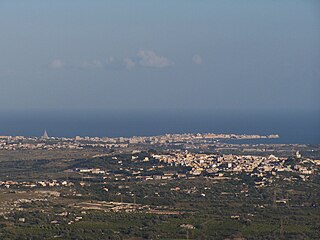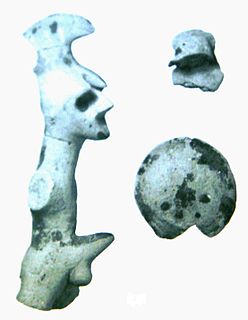| Canicattini Bagni | |
|---|---|
| Comune | |
| Comune di Canicattini Bagni | |
| Coordinates: 37°2′N15°4′E / 37.033°N 15.067°E Coordinates: 37°2′N15°4′E / 37.033°N 15.067°E | |
| Country | Italy |
| Region | Sicily |
| Province | Province of Syracuse (SR) |
| Area | |
| • Total | 15.1 km2 (5.8 sq mi) |
| Elevation | 362 m (1,188 ft) |
| Population (Dec. 2004) | |
| • Total | 7,415 |
| • Density | 490/km2 (1,300/sq mi) |
| Demonym(s) | Canicattinesi |
| Time zone | CET (UTC+1) |
| • Summer (DST) | CEST (UTC+2) |
| Postal code | 96010 |
| Dialing code | 0931 |
| Website | Official website |
Canicattini Bagni (Sicilian: Janiattini) is a comune (municipality) in the Province of Syracuse, Sicily (Italy), located about 190 kilometres (120 mi) southeast of Palermo and about 20 kilometres (12 mi) southwest of Syracuse. As of 31 December 2004, it had a population of 7,415 and an area of 15.1 square kilometres (5.8 sq mi). [1]
Sicilian, also known as Siculo or Calabro-Sicilian, is a Romance language spoken on the island of Sicily and its satellite islands. It is also spoken in southern Calabria, specifically in the Province of Reggio Calabria, whose dialect is viewed as being part of the continuum of the Sicilian language. Central Calabria, the southern parts of Apulia and Campania, on the Italian peninsula, are viewed by some as being part of a broader Far Southern Italian language group.

The comune is a basic administrative division in Italy, roughly equivalent to a township or municipality.

The Province of Syracuse is a province in the autonomous island region of Sicily in Italy. Following the suppression of the Sicilian provinces, it was replaced in 2015 by the Free municipal consortium of Syracuse. Its capital is the city of Syracuse, a town which was established by Greek colonists arriving from Corinth in the 8th century BC. It has an area of 2,109 square kilometres (814 sq mi) and a total population of 403,985 (2016). Syracuse has 8% of the Sicilian population and 8.2% of Sicily's area.
Contents
Its name derives from the Arabic Ayn-at-tin ('muddy spring'). The appositive Bagni ('baths' in Italian) does not indicate the presence of any thermal baths. Instead, it refers to the territory once belonging to the Danieli noblemen, lords of the Bagni fiefdom.
Canicattini Bagni borders the following municipalities: Noto, Syracuse.

Noto is a city and comune in the Province of Syracuse, Sicily, Italy. It is 32 kilometres (20 mi) southwest of the city of Syracuse at the foot of the Iblean Mountains. It lends its name to the surrounding area Val di Noto. In 2002 Noto and its church were declared a UNESCO World Heritage Site.

Syracuse is a historic city on the island of Sicily, the capital of the Italian province of Syracuse. The city is notable for its rich Greek history, culture, amphitheatres, architecture, and as the birthplace of the preeminent mathematician and engineer Archimedes. This 2,700-year-old city played a key role in ancient times, when it was one of the major powers of the Mediterranean world. Syracuse is located in the southeast corner of the island of Sicily, next to the Gulf of Syracuse beside the Ionian Sea.

















